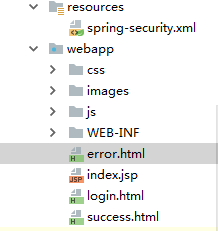SpringSecurity入门 一 的基础上进行配置:https://www.cnblogs.com/Cyan-W/p/9938723.html
请看SpringSecurity的依赖,和web.xml
下载一个登录模板:复制到webapp下面
- 把index.html页面命名为login.html页面,并修改form表单
<form method="post" action="/login"> 提交路径必须为/login
- 用户名 name = "username"
- 密码 name="password"
-
<form method="post" action="/login"> <li> <input type="text" class="text" name="username" value="Username" onfocus="this.value = '';" onblur="if (this.value == '') {this.value = 'Username';}"><a href="#" class=" icon user"></a> </li> <div class="clear"> </div> <li> <input type="password" value="Password" name="password" onfocus="this.value = '';" onblur="if (this.value == '') {this.value = 'Password';}"> <a href="#" class="icon lock"></a> </li> <div class="clear"> </div> <div class="submit"> <input type="submit" onclick="myFunction()" value="Sign in" > <h4><a href="#">Lost your Password ?</a></h4> <div class="clear"> </div> </div> </form>
- 编写一个success.html页面
- 编写一个error.html页面

二 修改Spring-security.xml 配置文件
<?xml version="1.0" encoding="UTF-8"?> <beans xmlns="http://www.springframework.org/schema/beans" xmlns:xsi="http://www.w3.org/2001/XMLSchema-instance" xmlns:security="http://www.springframework.org/schema/security" xsi:schemaLocation="http://www.springframework.org/schema/beans http://www.springframework.org/schema/beans/spring-beans.xsd http://www.springframework.org/schema/security http://www.springframework.org/schema/security/spring-security.xsd"> <!--配置资源不拦截--> <security:http pattern="/css/**" security="none"></security:http> <security:http pattern="/js/**" security="none"></security:http> <security:http pattern="/images/**" security="none"></security:http> <!--谷歌浏览器:请求被拦截会自动访问favicon.ico--> <security:http pattern="/favicon.ico" security="none"></security:http> <!--配置页面不拦截 pattern="" : 拦截的路径表达式 security="none":不拦截--> <security:http pattern="/login.html" security="none"></security:http> <security:http pattern="/error.html" security="none"></security:http> <!-- 配置拦截的规则 auto-config="使用自带的页面" use-expressions="是否使用spel表达式",如果使用表达式:hasRole('ROLE_USER') --> <security:http auto-config="true" use-expressions="false"> <!-- 配置拦截的请求地址,任何请求地址都必须有ROLE_USER的权限 --> <security:intercept-url pattern="/**" access="ROLE_USER"/> <!--配置自定义登录界面 login-page :指定登录界面 login-processing-url="login" 登录请求路径,登录表单必须提交到login default-target-url: ,登录成功后默认指向页面,如果有上一次请求,则执行上一次请求 authentication-failure-url: 认证失败的页面--> <security:form-login login-page="/login.html" login-processing-url="/login" default-target-url="/success.html" authentication-failure-url="/error.html"></security:form-login> <!--关闭跨站请求伪造--> <security:csrf disabled="true"></security:csrf> <!--security:logout 指定退出的信息 logout-success-url="" 退出成功后的跳转页面 logout-url: 退出请求路径 invalidate-session:是否会清空session --> <security:logout logout-url="/logout" logout-success-url="/login.html" invalidate-session="true"></security:logout> </security:http> <!-- 配置认证信息 --> <!--认证管理器--> <security:authentication-manager> <!--认证提供者--> <security:authentication-provider> <!--认证业务--> <security:user-service> <!--临时的账号和密码 {noop}:不使用加密方式 authorities="ROLE_USER" :认证的角色--> <security:user name="admin" password="{noop}admin" authorities="ROLE_USER"/> </security:user-service> </security:authentication-provider> </security:authentication-manager> </beans>
配置完就OK了,可以访问 http://localhost/